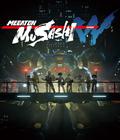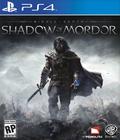Buy Middle-earth: Shadow of Mordor
Sometimes, it's easy to forget that it's OK for a video game to just be a video game. On the surface, Middle-earth: Shadow of Mordor seems like a silly and strange concept that's reminiscent of the half-baked The Lord of the Rings: The Third Age. What sets Shadow of Mordor apart is its wholehearted dedication toward being a fun video game.
Shadow of Mordor follows the story of Talion, a Ranger of Gondor. He guarded Mordor during the era when Sauron the wicked was thought to be dead and gone. Unfortunately, that meant that he was on the front lines when the dark lord returned. Talion's family was slaughtered in front of him as part of a dark rite that bound the soul of an Elf-Lord to Talion's own, dooming both to an undying existence. The wraithlike elf-lord and Talion must find a way to break their curse, and the only way to do that is to venture into Mordor, where the dark power is starting to stir.
To get one thing out of the way, Shadow of Mordor will give J.R.R. Tolkien purists a minor aneurism. The title uses Tolkien lore as a backdrop for what amounts to a superhero story. It's not disrespectful, but the primary interest was in making a video game, and accuracy to the source material came in a distant second. The title assumes you're familiar with The Lord of the Rings lore since the plot and characters are only briefly explained. Several characters from the movies make brief appearances that only are sensible within the context of the overall mythology, and several plot points rely on knowing the details. The characters are fun and the dialogue is snappy, but the plot meanders at an awkward pace. The villains are bland, and it's difficult to get excited about Talion's attack on Sauron when we know the plot doesn't end with him. This makes the ending particularly unsatisfying, since it's a loose setup for a sequel. The game makes Talion and his sidekicks fun, even if the core story is lacking.
With some different character skins, Shadow of Mordor could very well be the latest Batman game. Talion lacks the ability to glide and makes up for it with a super-speed run, but otherwise, the core elements of the Batman games are almost unchanged. The combat and stealth systems feel very familiar in a good way. Stunning an enemy allows you to perform a "flurry" attack, which is identical to a beatdown in Arkham City, and you even have Detective Vision in the form of "wraith vision." The game also uses the same combo meter system, and performing long combos allows you to use special finishing moves to instantly defeat the enemy.
It is to Shadow of Mordor's credit that it holds up so well in comparison to Arkham. The combat system lacks the quick-fire gadgets of Arkham City but makes up for it with a variety of new moves. Combat feels more deliberate when compared to Arkham but has a greater number of aggressive enemies. In some cramped areas, the camera goes behind a wall or ceiling and obscures the fighting for a moment. It rarely happens, but it's enough to let the enemy land a hit or two.
Stealth uses the same "predator" mechanics as Arkham, complete with environmental interaction. You can sneak up on enemies and dispatch them with a stealth kill, but you can also manipulate the environment. Explosive gunpowder or bee nests can be utilized to kill or terrify your enemy. In that way, it can feel a bit like Far Cry 3 at times. Since Talion kills his foes instead of knocking them out, he has more long-range capability than Batman. Enemies tend to be fairly nearsighted and often don't notice Talion unless he is particularly obvious about it. This can be disappointing when it's clear how dumb some of the enemies are, though.
One thing that really separates Talion from Batman is the bow. It may not see as much use as the sword, but when you use it, the bow feels significant and powerful. When you enter ranged mode, you go into a brief period of bullet time that allows you to line up and aim your shots. The bow has a bit of a charge time, but a headshot kills most enemies with a single shot, allowing you to kill multiple enemies in a row. Doing this in the middle of combat does not interrupt your combo as long as you don't wait too long. You can even fire off some arrows in the middle of a sword fight. Talion uses "elf arrows," which are spiritual shots made of magical energy. They can only be replenished by draining energy from enemies or finding elf arrow quivers in the environment.
As you upgrade it, the bow gains some cool abilities. The coolest power is Shadow Strike, which uses two arrows and instantly teleports you to the enemy you hit, even if he's well across the map. This is incredibly fun when you're stealthily moving through areas, since it lets you transverse huge distances without risking exposure.
Shadow of Mordor has one of the sharpest power curves I've seen in a game. You start off strong, and by the end of the game, you're nearly a god, but it feels completely natural. Every new move you get builds on something you've had previously. Enemies are hard-hitting and powerful, and you'll need every tool at your disposal to beat them. Even if you're a high-level character, you can be defeated if you're careless. A big part of this is that enemies are very aggressive and attack in large numbers. The game starts to feel a little easy near the end, but it continues to be fun.
The Nemesis system is one of the game's most touted features. On paper, it sounds too good to be true, but somehow, Shadow of Mordor manages to pull it off. Orcs, despite being iconic disposable bad guys, are individual entities in this title, and that has a big impact on how you play the game. The leaders of the Orc army are called captains, and each captain has a name and set of semi-randomly generated strengths and weaknesses. Some are strong against melee attacks or immune to finishing moves, while others are scared of bees or weak to stealth kills. The lower an Orc is on the totem pole, the more weaknesses and fewer strengths he has. The warchiefs, the guys who run the place, have almost no weaknesses and tons of strengths, so it can be risky to fight them.
If you fight an Orc and escape without killing him, that Orc remembers and mocks you the next time you meet. If you set an Orc on fire and force him to run, he'll have scars and a bad temper the next time. Perhaps the coolest feature is how death is handled. Talion is technically immortal, but he can be temporarily killed. An Orc who kills Talion gets a promotion. If he was a nameless soldier, he gets a name and a chance to become a captain.
This also plays into the Orc hierarchy system, where they range from low-ranking captains to warchiefs. Even if Talion does nothing, Orcs clash with one another. Warchiefs have bodyguards who protect them in an emergency, and Orcs may attempt to earn the honor of becoming a bodyguard. A successful power play by a captain raises their power level, reduces their weaknesses and increases their strengths. Talion can interrupt these power plays or use them to his advantage. If a bodyguard gets into a duel, you can secretly help his opponent. If an Orc is throwing a feast, you can poison the grog to prevent him from powering up. There is an influx of new Orcs to replace the ones you kill, and there's a constantly shifting social structure that Talion can exploit.
Branding allows you to permanently turn an Orc to your side, and it completely changes how the game plays. It can be done in combat, in stealth or by grabbing an Orc when it's weak. Once an Orc is branded, he fights on your side. Branded Orcs still count as enemies, so you can kill them in battle (intentionally or accidentally) and use them to build your combo meter. They don't attack you but gladly beat the living daylights out of your enemies. You can also brand beasts in the environment to make them fight for you. You can ride the beasts to gain additional power, although mounted combat is far more simplistic than on-foot combat, and it tends to be less fun, too.
In one particularly cool scenario, I killed an Orc captain only to discover that the nameless replacement was an Orc I'd branded in an earlier battle. There is a difference between branded mooks and branded captains. Once you brand a captain, you can give him an order to kill other captains, become a bodyguard for a warchief, or try to assassinate the warchief.
There is one significant downside to branding. Killing a captain or warchief can cause runes to drop. The runes can do anything from restore health upon gaining combo to increasing your running speed to giving bow shots a chance to make enemy heads explode. The more powerful the enemy, the better the rune. They add a huge amount of power to Talion, but they only drop if you kill your enemy. This means that any time you brand a powerful foe, you're sacrificing power in exchange for a useful ally.
A big part of the fun in Shadow of Mordor is how much freedom you have. Aside from a few plot missions that serve as tutorials, you're given free rein in how you want to handle situations. When killing a warchief, you can rush in and fight him, exploit his weaknesses to kill him in a single hit, turn his bodyguards against him and have him assassinated, or weaken him and turn him to your own cause. As far as the game is concerned, they're all valid choices. The more linear missions tend to have a more binary choice between stealth and combat. There are a couple of missions that basically demand stealth, but even then, you can fight your way through as long as you kill enemies before they can sound the alarm.
The "plot" missions are the least interesting part of Shadow of Mordor. Most serve as a tutorial for one or more of the game mechanics. The last boss is nothing but a brief quick time event (QTE), and considering the freedom you have in the rest of the game, it feels really unsatisfying.
There's quite a bit of content in the game. There are 20 core plot missions and a huge amount of extra side missions. You can rescue slaves from the Orcs, and that unlocks special rescue missions. There are special self-contained challenges based on the bow, stealth or sword, and the player can take them on in exchange for big rewards. There's a vast number of collectibles. Finishing the main game will take around 12-15 hours, depending on how straightforward you are about running into warchief strongholds, but there are side missions and some extra content.
Also available at launch is the "Test of Power" DLC, which adds a challenge mode. A map of Orc captains and warchiefs is randomly generated, and you must defeat as many as possible within a time limit and without dying. It's a nice way to get the fun of the hierarchy-based combat without having to go through the story. You can approach the combat however you like, but the more effective your assassinations, the higher your score. The Test of Power tasks players with killing three warchiefs and 10 captains in under 30 minutes while getting high marks on each. It's a surprisingly fun challenge even for a high-level character, since optimally taking down your foes is harder than it sounds. The Season Pass will include trials of Wisdom and Speed in addition to an endless challenge mode, but we were unable to test those in our review copy.
Shadow of Mordor is a good-looking game, but in some places, it's clear that it was designed for both current- and last-gen systems. The character models are nice enough, and the animations look great, but some of the textures (especially hair) look weak. The game runs smoothly, although I encountered some slowdown during huge battles with lots of special effects. Troy Baker continues his quest to be every video game protagonist, and he does a good job as Talion. He hits the same tragic-dead-family notes as several of his other roles, but he's very charismatic. Most of the voice acting is excellent and made me like characters who otherwise felt like clichés. It helps carry the story through some of its weaker moments and infuses the characters with life.
Middle-earth: Shadow of Mordor is the rare Arkham clone that transcends its status. It borrows heavily from Batman: Arkham Asylum but does enough new, interesting and distinctive things that it doesn't feel derivative. The core gameplay mechanics are some of the most enjoyable I've encountered this year, and the game is fun from start to finish. A lackluster plot and odd use of the source material holds the game back slightly but not enough to interfere with the unadulterated fun of the core concept. Shadow of Mordor may not be the deepest or most meaningful game released this year, but it sure is one of the most fun.
Score: 9.0/10
More articles about Middle-earth: Shadow of Mordor











 Middle-earth: Shadow of Mordor is a third-person action game set in Middle-earth that explores an original story of vengeance and redemption.
Middle-earth: Shadow of Mordor is a third-person action game set in Middle-earth that explores an original story of vengeance and redemption.




























